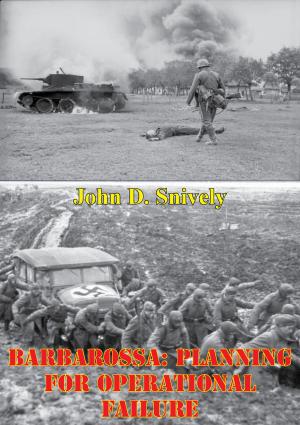An Analysis of Manstein’s Winter Campaign on the Russian Front 1942-1943:
A Perspective of the Operational Level of War and Its Implications
Nonfiction, History, Germany, European General, Military, United States| Author: | Lt.-Col. Lawrence L. Izzo | ISBN: | 9781786254641 |
| Publisher: | Verdun Press | Publication: | November 6, 2015 |
| Imprint: | Verdun Press | Language: | English |
| Author: | Lt.-Col. Lawrence L. Izzo |
| ISBN: | 9781786254641 |
| Publisher: | Verdun Press |
| Publication: | November 6, 2015 |
| Imprint: | Verdun Press |
| Language: | English |
This study is a historical analysis of the campaign waged by Field Marshal von Manstein on the Russian southern front during the winter 1942-43. The study begins just after the 6th Army’s encirclement in Stalingrad and describes the four principal phases of Manstein’s campaign: the attempted relief of the 6th Army; the protection of Army Group A as it disengaged from the Caucasus; the prevention of Manstein’s lines of communications from being cut; and the counterblow to regain the initiative.
The lessons learned from the campaign provide a perspective of battle at the operational level of war. The factors leading to Manstein’s success are discussed and include: superior generalship at the operational level; superior tactical maturity of the Germans; and German tactical and operational agility. The study describes the transition from the operational defensive to the operational offensive and how a defender can have the initiative. Manstein’s use of depth is explained. The concepts of center of gravity and operational art as they pertain to this campaign are also described.
The study concludes with the implications of the lessons learned for a NATO-Soviet conflict in a central European scenario. The study points out that Manstein demonstrated that victory is possible even when forced to react to the enemy’s plan. The ability of NATO to replicate, today, the agility of Manstein’s forces and the synchronization achieved by his commanders is questioned. The implications of NATO’s lack of operational depth, in contrast to Manstein, are described. The impact of changes in force design since World War II are also explained.
This study is a historical analysis of the campaign waged by Field Marshal von Manstein on the Russian southern front during the winter 1942-43. The study begins just after the 6th Army’s encirclement in Stalingrad and describes the four principal phases of Manstein’s campaign: the attempted relief of the 6th Army; the protection of Army Group A as it disengaged from the Caucasus; the prevention of Manstein’s lines of communications from being cut; and the counterblow to regain the initiative.
The lessons learned from the campaign provide a perspective of battle at the operational level of war. The factors leading to Manstein’s success are discussed and include: superior generalship at the operational level; superior tactical maturity of the Germans; and German tactical and operational agility. The study describes the transition from the operational defensive to the operational offensive and how a defender can have the initiative. Manstein’s use of depth is explained. The concepts of center of gravity and operational art as they pertain to this campaign are also described.
The study concludes with the implications of the lessons learned for a NATO-Soviet conflict in a central European scenario. The study points out that Manstein demonstrated that victory is possible even when forced to react to the enemy’s plan. The ability of NATO to replicate, today, the agility of Manstein’s forces and the synchronization achieved by his commanders is questioned. The implications of NATO’s lack of operational depth, in contrast to Manstein, are described. The impact of changes in force design since World War II are also explained.



![Cover of the book Desert Warfare: German Experiences In World War II [Illustrated Edition] by Lt.-Col. Lawrence L. Izzo](https://www.kuoky.com/images/2014/august/300x300/9781782893776-MTwr_300x.jpg)
![Cover of the book At Close Quarters; PT Boats In The United States Navy [Illustrated Edition] by Lt.-Col. Lawrence L. Izzo](https://www.kuoky.com/images/2015/november/300x300/9781786252067-v2lq_300x.jpg)



![Cover of the book JAPANESE IN BATTLE 1st Edition [Illustrated Edition] by Lt.-Col. Lawrence L. Izzo](https://www.kuoky.com/images/2014/august/300x300/9781782896180-id7m_300x.jpg)






